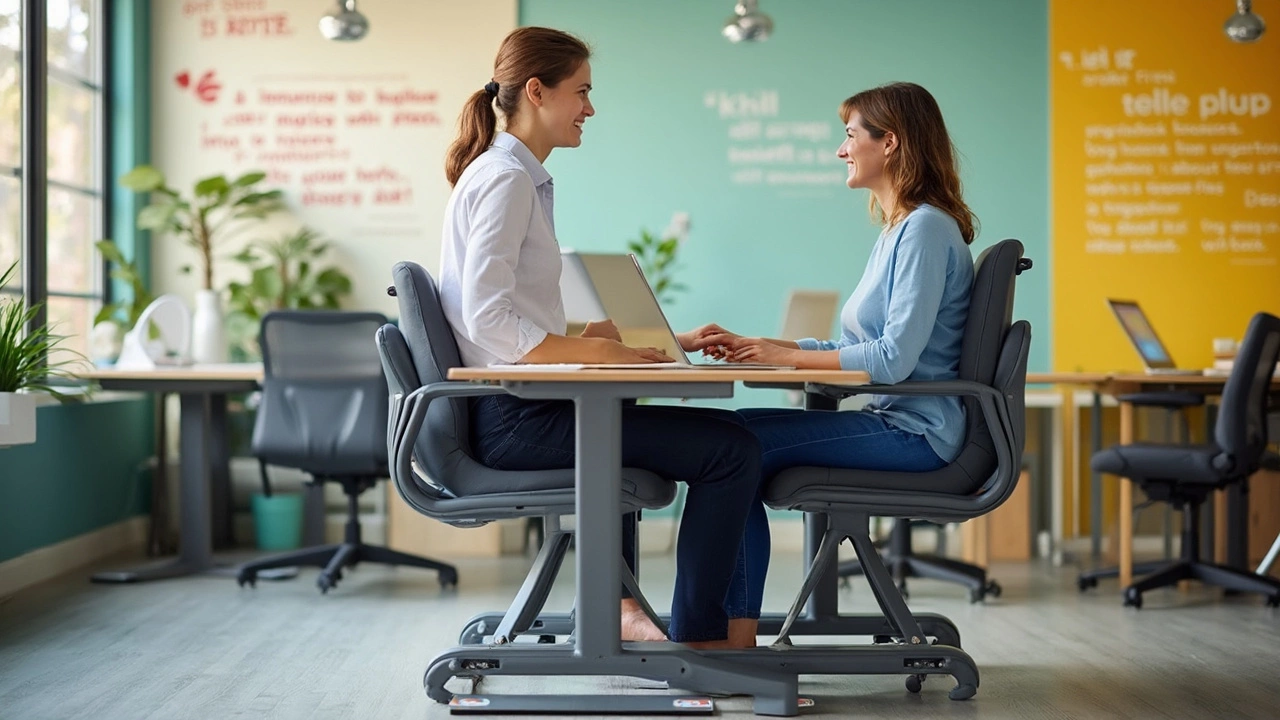 17
Feb,2025
17
Feb,2025
Figuring out whether it’s better to have your chair high or low can make all the difference in how you feel and perform during those long hours at your desk. It's not just about aesthetics or personal preference; it's about getting your posture right and your productivity high.
First things first, let’s talk about why chair height matters. A chair set too high, and you might find yourself straining your neck and shoulders. Too low, and your legs could feel cramped, or your circulation might suffer. That’s why getting the right height can be a game-changer for your work comfort and even your health.
One nifty trick for checking if your chair is at the right height is to see if your feet are flat on the floor. Also, look for a slight angle in your knees—around 90 degrees is what you’re aiming for. It’s these little adjustments that can lead to big changes in how you feel at the end of the day.
Stay tuned as we dig deeper into how ergonomics can offer you more than just comfort, turning your daily grind into a much more pleasant experience.
- Importance of Chair Height
- Ergonomics: The Science of Comfort
- When High Chairs Help
- Advantages of Lower Chairs
- Finding the Sweet Spot
- Practical Tips for Chair Adjustment
Importance of Chair Height
Your office chair height isn't just a minor detail—it plays a crucial role in maintaining both your health and productivity. Sitting at the wrong height can throw your whole posture out of whack, which might leave you with achy joints or even long-term injuries.
Comfort and Posture
Starting with comfort, the right chair height supports your spine's natural curve. If your chair is too high, you might end up hunching over your desk, which isn’t fun for anyone’s back or shoulders. Lower it too much, and you could find yourself slouching. Either way, the wrong height can lead to a heap of discomfort and potential health issues.
Health Implications
Speaking of health, there's more to gain than just comfort. Proper chair height improves circulation. How? Well, when your feet are flat on the ground, it helps blood flow smoothly, reducing fatigue and potential swelling. In fact, studies have shown that people who maintain proper sitting posture with the right chair height experience fewer musculoskeletal problems.
Boosting Productivity
Now, let's chat about productivity. Imagine trying to work while constantly fidgeting. Not exactly a recipe for getting things done, right? With the right chair adjustment, you can focus better, work longer without discomfort, and maybe even feel more enthusiastic about tackling those never-ending to-do lists.
Here’s a stat to chew on: workers with ergonomic setups, including proper chair height, report a 15% boost in productivity compared to those without. So, adjusting your chair’s height isn’t just good for you—it's good for business too!
| Chair Height | Potential Benefits |
|---|---|
| Too High | Boosts visibility but strains neck and shoulders. |
| Just Right | Improves posture, health, and productivity. |
| Too Low | Reduces visibility and circulation, leads to slouching. |
Every little adjustment counts when it comes to your workspace. Setting your office chair to the correct height is a simple step that can bring about significant changes. Trust us, your back will thank you!
Ergonomics: The Science of Comfort
Ergonomics isn't just some buzzword thrown around in office design—it’s a legit science that’s all about designing workspaces and tools that fit you, not the other way around. The main goal? Minimizing discomfort and preventing injury. In the world of office chairs, that’s where ergonomic seating comes into play. It's all about making sure your chair supports the natural curve of your spine and provides proper support.
The Three Key Principles
First off, let's break down what you should know:
- Posture Support: Your spine has a natural S-curve, and a good ergonomic chair should support this shape. This keeps back pain at bay and helps you sit up comfortably. Look for chairs with lumbar support that can be adjusted to match your spine's natural curve.
- Adjustability: Everyone's body is different, so having options is key. A chair that allows you to adjust height, armrests, and back height meets the diverse needs of office workers. This ensures you can personalize your chair to your own body for maximum comfort.
- Mobility: Believe it or not, staying put for hours isn’t exactly a recipe for a happy body. An ergonomic setup encourages dynamic movement—whether it's a chair that swivels or a seat that enables slight rocking. Movement keeps the blood flowing and reduces stiffness.
Does It Really Help?
You bet! Studies have shown that having ergonomic seating reduces musculoskeletal complaints and fatigue, boosting productivity by up to 25%. When your chair has your back—literally—you’d be surprised at how much more you can get done without the distraction of lingering pain or discomfort.
And here's a little tip: before you invest in any office chair, spend some time ensuring it's ergonomic. This small detail aligns your workstation with how your body naturally moves and works, leading to a workstation that keeps you comfy all day long.
When High Chairs Help
Sitting in a chair that's higher off the ground can actually bring a bunch of benefits, especially if you're in a certain type of job or have specific physical needs. But it's not just about feeling like you're on a throne; there's more to it.
Better Visibility
If your work involves a lot of desk space or multiple monitors, a higher office chair height can give you a better line of sight. This way, you don't end up with a sore neck from constantly peeking over things or stretching your head up.
Improved Posture
Those longer-legged folks might find a higher chair better for maintaining a good posture. When the chair’s at the right height, your eyes naturally align with the computer screen, keeping your spine in a comfy, healthy position.
Flexibility in Leg Movement
A higher chair can provide more room for your legs to move around. This can be a relief if you tend to shift a lot during the day or if you like to change up your seating position.
Enhanced Blood Circulation
Keeping your feet flat on a higher foot platform or even a footrest while using a high chair can help in promoting better circulation, which is key if you spend hours at the desk.
Jobs that Benefit from High Chairs
Certain jobs, like designers and architects, who often deal with large tables or workstations, might find a higher chair more practical to match their setup.
However, it's not always perfect. If set too high, it could lead to dangling feet if you're shorter, which isn't ideal. Always pair it with the right furniture or footrest to maintain that ergonomic edge.

Advantages of Lower Chairs
Let’s get into why you might want to keep your office chair height on the lower side. There’s more to it than just a change in view. A lower chair can actually help maintain a better posture, which is crucial for long-term health.
Ergonomics doesn’t stop at comfort; it dives into efficient body mechanics. Sitting lower can help align your hips and spine better, reducing the chance of slouching. You’ll notice less strain on your lower back, a common issue when sitting for long hours.
Enhanced Circulation
When you’re sitting too high, your legs might dangle or your thighs could press against the edge of the seat. This position can hamper blood flow. A lower chair keeps your feet flat on the ground, promoting better circulation, and potentially keeping energy levels up throughout the day.
Improved Stability
A lower chair often means your center of gravity is closer to the floor, giving you added stability. Imagine not having to readjust constantly because you feel wobbly or off-balance. This stability can enhance your focus and productivity.
Avoiding Neck Strain
If your desk is set lower, a lower chair helps you keep from craning your neck downwards, which can lead to neck strain and tension headaches. Pairing your chair height with the right desk height is essential to avoid these common issues.
Remember, it's key to balance things out with regular breaks and movements to keep things flowing well. Adjust your chair to find that sweet spot and you’ll likely see a boost in both comfort and work efficiency.
| Benefit | Explanation |
|---|---|
| Good Posture | Aligns spine and hips better |
| Enhanced Circulation | Feet flat on the ground |
| Improved Stability | Close center of gravity |
| Avoid Neck Strain | Prevents craning neck downwards |
Finding the Sweet Spot
Finding that perfect height for your office chair can be like striking gold. We've all heard about ergonomics, but what does it really mean when it comes to adjusting your chair?
Let’s break it down into three easy steps:
Check Your Feet and Legs
Start by ensuring your feet are flat on the ground. Dangling feet are a no-go. They can lead to discomfort and even circulation issues. Aim for that 90-degree rule with your knees, where your legs form a right angle. You shouldn’t feel like you're reaching or cramped.
Look at Your Desk Height
Your chair works in conjunction with your desk. The height of your chair should let your arms rest comfortably on your desk without having to hunch your shoulders or feel like you’re stretching. Generally, your elbows should be at about a 90-degree angle, similar to your legs, while typing or using a mouse. Consider an adjustable desk if possible, as it can provide more flexibility in the long run.
Fine Tuning with Ergonomic Features
Many ergonomic seating options come with adjustable features, like seat tilt and armrest height. Don’t shy away from using them. Adjusting the seat tilt can help distribute your weight evenly and reduce pressure on your spine.
Test and Adjust
- Sit back in the chair with your back fully supported by the backrest.
- If you can’t place your feet flat, use a footrest for support.
- Adjust the armrests so your arms are supported at a 90-degree angle.
Remember, no setting is one-size-fits-all, so if it’s cozy and supports you well, you’ve probably hit the jackpot. Your body will thank you!
Lastly, don’t get glued to your seat. Even the most perfectly adjusted chair can’t replace the benefits of getting up and moving around a bit. Incorporate some movement breaks into your work routine. Sit less, move more, and you’ll notice a world of difference.
Practical Tips for Chair Adjustment
Getting the chair height just right isn't rocket science, but it certainly helps to follow some tried-and-tested tips. If you nail this, you're on your way to a comfy workday free from those annoying aches and pains.
1. Start with Your Feet
Ensure your feet are flat on the floor. If you're on the shorter side and your feet dangle like a kid on a bar stool, consider using a footrest. This minor tweak can improve your blood circulation and reduce fatigue.
2. Adjust Your Seat Height
Use the lever beneath your chair to adjust its height. Get the seat level to the point where your knees are at a 90-degree angle or slightly lower, preventing any unnecessary pressure on the back of your thighs. When your thighs are parallel to the ground, you're usually in the ergonomic sweet spot.
3. Check Your Armrest Level
Make sure the armrests are at a height where your shoulders feel relaxed. You shouldn't have to scrunch up your shoulders to use them. With your elbows at around a 90-degree angle, your armrests should easily support your forearms while typing.
4. Back Recline Angle
A slight recline is actually healthy for your back. Aim for about a 100-110-degree recline while keeping your lower back snugly supported by the chair's backrest.
5. Desk and Monitor Alignment
Having your chair set properly means nothing if your desk setup is not in sync. Your monitor should be at eye level, and your desk shouldn't force you to hunch over or reach uncomfortably.
| Feature | Ideal Measurement |
|---|---|
| Seat Height (from floor to seat) | 16-21 inches |
| Knee Angle | 90 degrees |
| Back Recline | 100-110 degrees |
Consider these tips a part of your daily routine, much like your morning coffee or a quick workout. Once you've got everything set up, you'll wonder how you ever sat any other way.




